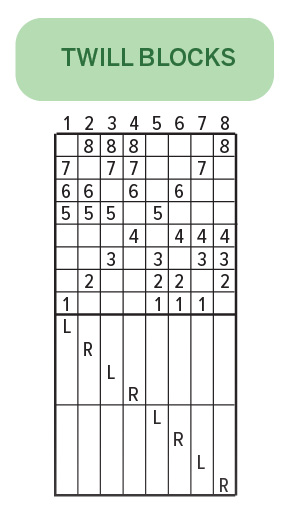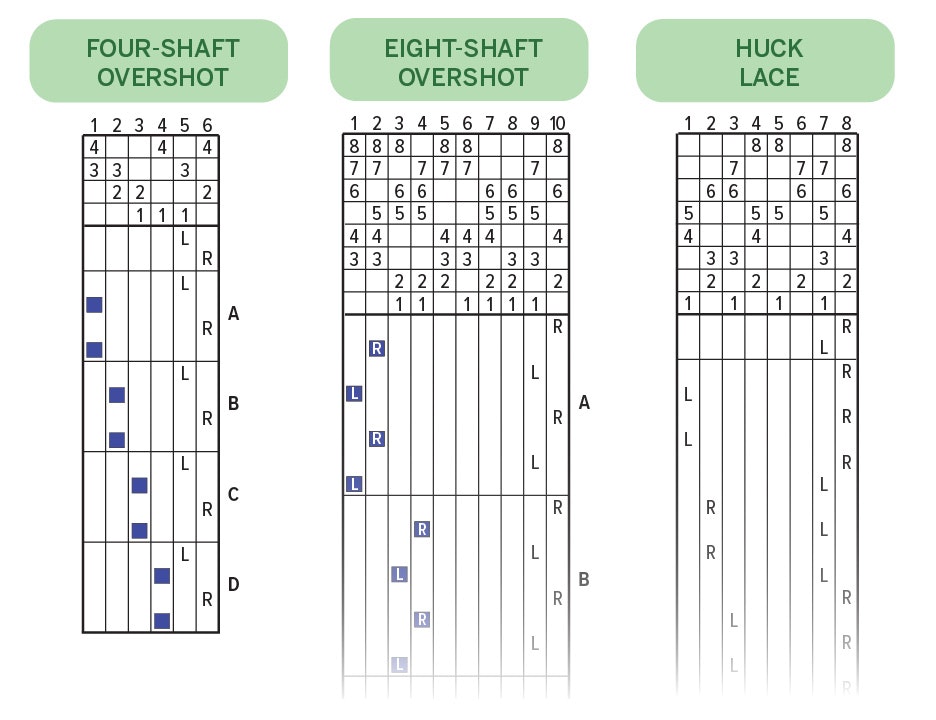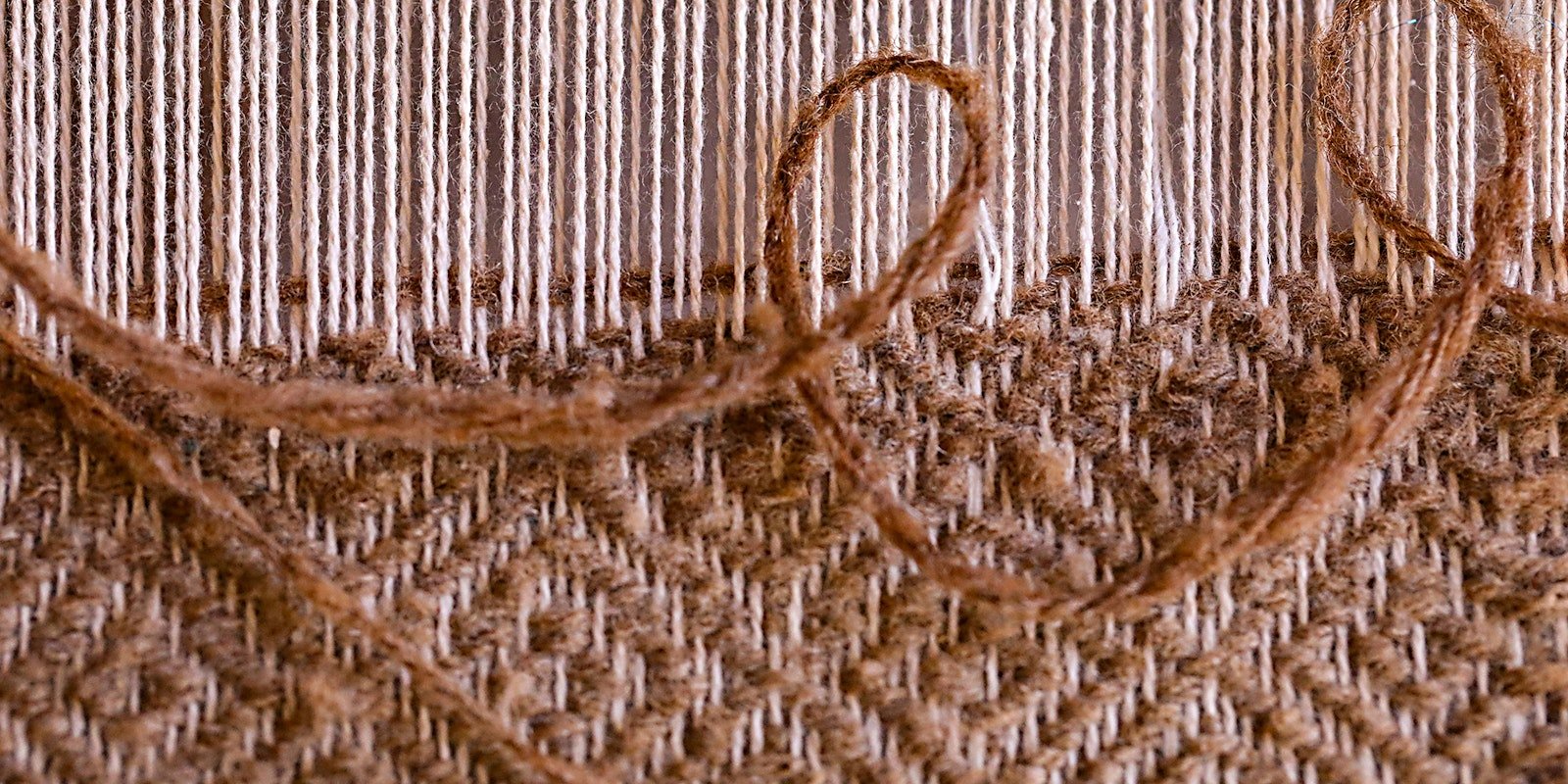Dear Madelyn,

I keep losing my place when I’m weaving. Do you have any tips for keeping track of treadling orders? —Katrina
Hi Katrina!
I like to arrange tie-ups and treadles in a way that helps me keep track. Since I pay attention to the cloth as I weave, I have a good idea about what it’s supposed to look like. But if I get distracted, I have an easy way of figuring out what should come next: I simply look at where the shuttle is—on the left or on the right—to help me find my place. If the shuttle is on the left, the next treadle will usually have an odd number; if the shuttle is on the right, it will have an even number.
That works out because much of the weaving we do uses treadles either in sequential order (as with many twills), or in alternating order (for plain weave or tabby).
Let’s look at a few examples. The treadling sequences below show L (for odd treadle numbers, with the shuttle starting on the left side) and R (for even treadle numbers, with the shuttle starting from the right side).
Note: Don’t be confused—the Ls and Rs in the figures below don’t indicate which foot you should treadle each pick with. They indicate the side that a shuttle starts on, and whether the treadle to be used has an even or odd number.

Sequential Treadling
In many twill sequences, odd treadles alternate with even treadles. When I'm weaving twills and the shuttle is on the left, I know I’ll need to use an odd treadle for the next pick; when the shuttle is on the right, I’ll need to use an even treadle. The twill blocks draft shown here demonstrates this pattern.
After I press treadle 1, the shuttle will move from left to right; after I press treadle 2, the shuttle will move from right to left; and so on through the treadling sequence.
If I lose my way and start weaving with the wrong treadle (even if it’s on the correct side), the fabric will immediately tell me that I made a mistake.
Alternating Treadling

For structures that use tabby, I always use the leftmost of the tabby treadles when my tabby shuttle is on the left, and the rightmost when my tabby shuttle is on the right. This practice applies regardless of where I place my tabby treadles in the tie-up—on the left side, on the right side, or with one on each side.
The four-shaft overshot draft above has its tabby tie-up on treadles 5 and 6, and its pattern tie-up on treadles 1–4. As before, an L in the treadling means that the tabby shuttle is on the left and I need to use treadle 5; an R means it’s on the right and I need to use treadle 6.
In this draft, the same pattern treadles are used for two picks in a row, so they don’t follow the left/right sequence. You have to watch the fabric to see where you are as you weave—but the alternating tabby picks should help you stay on track.
In eight-shaft overshot, two alternating pattern treadles are used for each block, so the same principle can sometimes be applied to the pattern weft (shuttle on the left for the left or odd-numbered treadle of the pair; shuttle on the right for the right or even-numbered treadle of the pair) as well as to the tabby weft (on treadles 9 and 10). The sample draft above has this type of alternating pattern treadling.
But as in the four-shaft overshot example, the same pattern treadles may be used for multiple picks in a row, so you’ll need to watch the fabric as you weave—and use the alternating tabby picks to orient yourself.
In huck lace, an even/odd alternation of shafts 1 and 2 on the pattern and tabby treadles allows a tie-up in which an even tabby treadle (shuttle coming from the right) always alternates with an odd pattern treadle (shuttle coming from the left), or an odd tabby treadle always alternates with an even pattern treadle.
Try it Yourself
When you’re getting ready to weave, consider whether this left/right–odd/even sequence will work for your draft. If it will, give it a try to see if it helps.
Some structures and treadling orders don’t lend themselves to this practice, of course. The most important aid to following any treadling sequence is closely observing the connection between it and the resulting cloth so that you know right away when you have made a mistake and what to do to correct it.
—Madelyn
Have a weaving question? Email Madelyn!
View more advice from Madelyn.
Published March 26, 2018; updated October 15, 2025.

